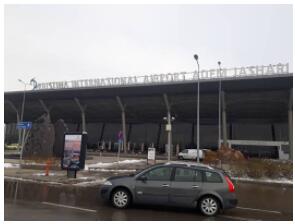Special neighborhoods, streets and squares
Jewish Quarter
Antwerp has the largest Jewish Orthodox community in Europe with around 20,000 people. Many live in the area around the train station, which is therefore strongly influenced by them. They are primarily descendants of the Jews who were expelled from Spain and Portugal in the 16th and 17th centuries and who found a new home in Antwerp. There they entered the diamond trade and made Antwerp the world’s most important trading center for these gemstones.
There are numerous jewelers and four diamond exchanges here. The “Pelikanstraat”, which runs through the quarter, is the largest diamond mile in the world. Recently, however, the diamond trade has become increasingly dominated by Indian traders.
At the beginning of the 1990s, around 30,000 diamond cutters were working in the streets around the diamond exchange on Hoveniersstraat, compared to only around 3,000 in 2015.
Meir
The city’s most important shopping mile connects the main train station with the “Grote Markt” (large market). It is closed to vehicles and is probably the liveliest street in town, where people like to stroll up and down.
In addition to some impressive buildings from the Wilhelminian era, there are numerous shops, department stores and cafes here.
Grote Markt
The central square in the heart of the old town is lined with magnificent guild houses. The entire west side of the “Great Market” is taken up by the facade of the town hall from 1564.
In the middle of the square, which is considered to be one of the most beautiful in Belgium according to cheeroutdoor, stands the “Brabro Fountain”, which was built at the end of the 19th century and tells the legend of the city’s foundation around Sivio Brabo and the giant with the severed hand.
Kievit district
This term is not the official name for this district, which is located behind the main train station. It extends roughly along both sides of the Kievitstraat between Grafschaft Straße, Plantin en Moretuslei, the Antwerp Zoo and the Central Station. The district is home to a number of Flemish government offices, the Alcatel Tower and a number of high-rise buildings.
Tentoonstellingswijk
After the 1930 World’s Fair, a completely new neighborhood arose on the site, now known as Tentoonstellingswijk.
Theaterplein
Markr takes place on the Theaterplatz on Saturday and Sunday. On Saturdays, among other things, delicious food is offered, while on Sundays the market is more of a flea market character. It is worth mentioning that the square is spanned by a large roof. The plans for this canopy come from landscape architects from the Associato Secchi-Vigano studio in Milan. This also includes a green space that invites you to linger.
Vlaeykensgang
This small alley is surrounded by whitewashed houses from the 16th century. In the past it was mainly cobblers who lived and worked here. Nowadays the visitor will find a number of very good and recommendable restaurants in the houses. Many people consider this narrow alley with its picturesque charm to be the most beautiful in Antwerp. Be that as it may, a visit to this alley near the Cathedral of Our Lady is definitely recommended.
Swimming pool in the Veldstraat
This complex was built in the course of the seventh Olympic Games in Antwerp in 1920, in the Art Deco style.
It should be noted that Germany, Austria, Bulgaria, Hungary and Turkey were excluded from the games.
For more information, such as opening times, see: “Stadium, swimming pools”
Veldstraat 83
2060 Antwerp
Tel.: 0032 – (0) 3 – 259 23 55
veldstraat@sportoase.be
Waasland road tunnel
This road tunnel connects – like the Sankt-Anna-Tunnel – a new quarter built after the First World War on the left bank of the Scheldt opposite the historic city center with the city center.
In contrast to the pedestrian and bicycle tunnel, this tunnel can also be used by cars. It was inaugurated together with the St. Anna Tunnel on September 10, 1933.
The tunnel has a total length of 2,111 m, while the covered part has a length of 1,769 m.
This tunnel was also badly damaged in the retreat battles of the Germans in 1944 and rebuilt after the war.
Het Steen Castle
The stone castle Het Steen (The Stone) was built between 1200 and 1225 and was part of the city fortifications at that time. Before that, a refuge castle fortified with earth walls had stood here since the 9th century. This makes the facility the oldest building in Antwerp.
In 1520 the castle was extensively renovated at the instigation of Emperor Charles V (1500-1558).
In the 18th century there was a prison within the castle walls. After that, a sawmill and a fish warehouse were housed here.
From 1862 to 2008 the building was used as a museum – first for historical exhibitions and later as a maritime museum.
The local “National Maritime Museum” moved to the Museum on the River (MAS) in 2008.
The castle can be visited.



